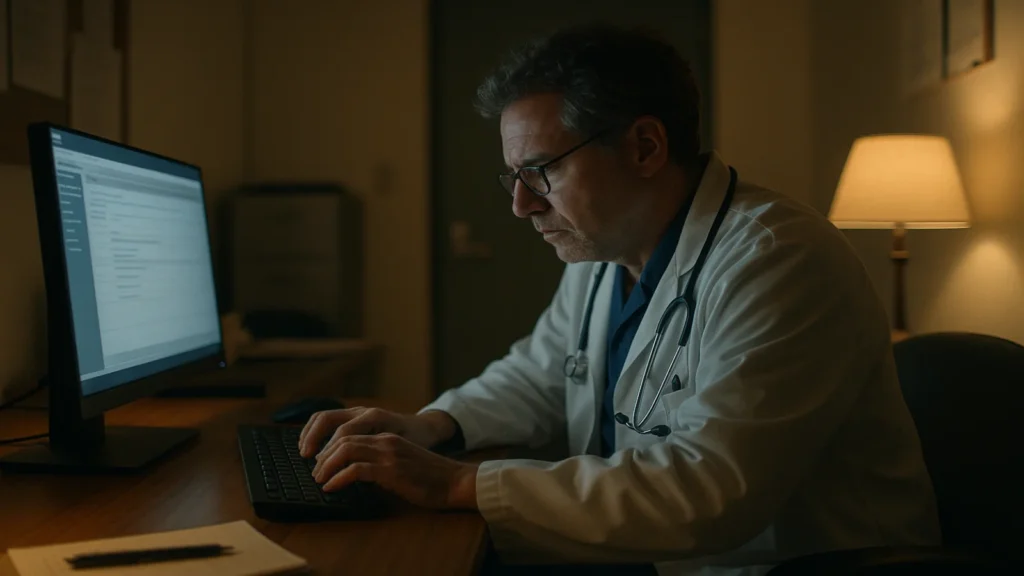
Clinical documentation keeps care safe—but the load has ballooned. In ambulatory practice, physicians spend nearly two hours on EHR/desk work for every hour of face-to-face care, often adding ~1–2 hours of after-hours “pajama time.” This time tax fuels burnout and steals attention from patients and teams. Below, I unpack how documentation drains time, strains relationships, pressures small-practice finances, and erodes fulfillment—and what we can do about it.
By the numbers
- ~2:1 EHR/desk work to patient face time.
- ~5.9 hours/day in the EHR for primary care; ~1.4 hours after clinic to finish.
- Burnout: ~62.8% (2021) → ~45.2% (2023)—improved, but still high.
- Economic drag: ≈ $4.6B/year nationally from turnover and reduced clinical hours.
The Insatiable Thief of Time
Time—the scarcest resource in clinic—is being consumed by documentation. Across specialties, physicians spend close to two hours on EHRs/desk work for every one hour with patients, with another 1–2 hours logged after hours. That’s time not spent with patients, teaching, or simply recovering for the next day.
Where the minutes hide
Documentation, inbox management, orders, coding, refills, prior auth, and navigating clunky interfaces—all part of the administrative burden that has crept into the physician’s day.
Documentation as a Burnout Driver
The documentation load is tightly linked to burnout. After peaking during the pandemic, burnout improved but remains elevated relative to historical baselines. Workflow friction and clerical load destabilize well-being, retention, and workforce capacity.
When Paperwork Overshadows People
EHR use in the exam room changes communication—especially eye-gaze and shared attention—making it harder to build rapport if not handled intentionally. The goal isn’t less documentation; it’s better documentation workflows that keep the patient at the center.
The Financial Strain on Small and Independent Practices
Documentation overhead shows up on the P&L. Slower throughput, turnover from burnout, and onboarding replacements add up. Nationally, physician burnout is estimated to cost about $4.6B annually—a burden that disproportionately hurts small practices with thinner margins.
Beyond the Obvious: The Erosion of Professional Fulfillment
Perhaps the quietest cost is meaning. Many of us trained to diagnose, heal, and connect—yet feel reduced to data entry. Over time, that mismatch drains joy and innovation. Rebalancing the work so clinicians practice at the top of their license is not a luxury; it’s essential to quality and sustainability.
Reclaiming Time—Without Cutting Corners
Practical steps clinics are using now:
- Smart templates & visit prep: Problem-oriented skeletons, pre-charting checklists, and “default-good” orders reduce clicks.
- Team-based inbox: Protocols for refills/results, RN/MA first-pass triage, and batch messaging windows.
- Documentation sprints: 5–10 minute “note-finisher” blocks mid-session to avoid end-of-day pileups.
- EHR optimization: Shortcuts, dot phrases, order sets, and removing low-value alerts.
- AI-assisted documentation with human QA: Offload first-draft note creation and keep clinician oversight on accuracy and nuance.
Conclusion
The burden of clinical documentation consumes time, fuels burnout, erodes patient connection, strains finances, and dulls fulfillment. These are connected problems—and solvable ones—when we redesign workflows and bring the right mix of people, process, and technology to the point of care.
Ready to reclaim your time? CuraFlow pairs physician-designed workflows with AI-assisted documentation and human QA so you finish notes during clinic—not at 10 p.m. Book a consult today to see what this looks like in your specialty.
Ready to reclaim your time?
CuraFlow pairs physician-designed workflows with AI-assisted documentation and human QA so you finish notes during clinic—not at 10 p.m.Schedule a consultation today to see what this looks like in your specialty.